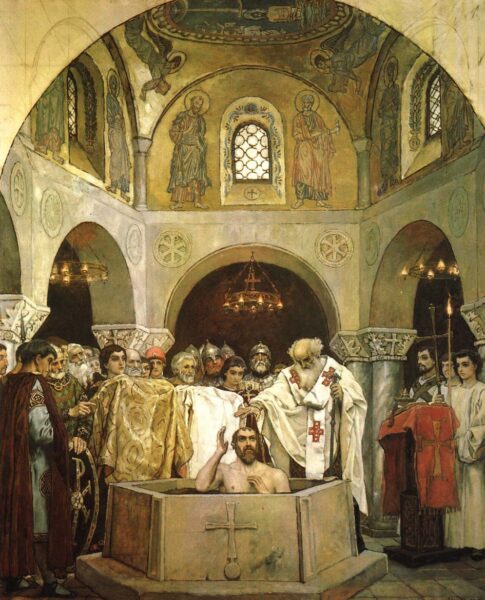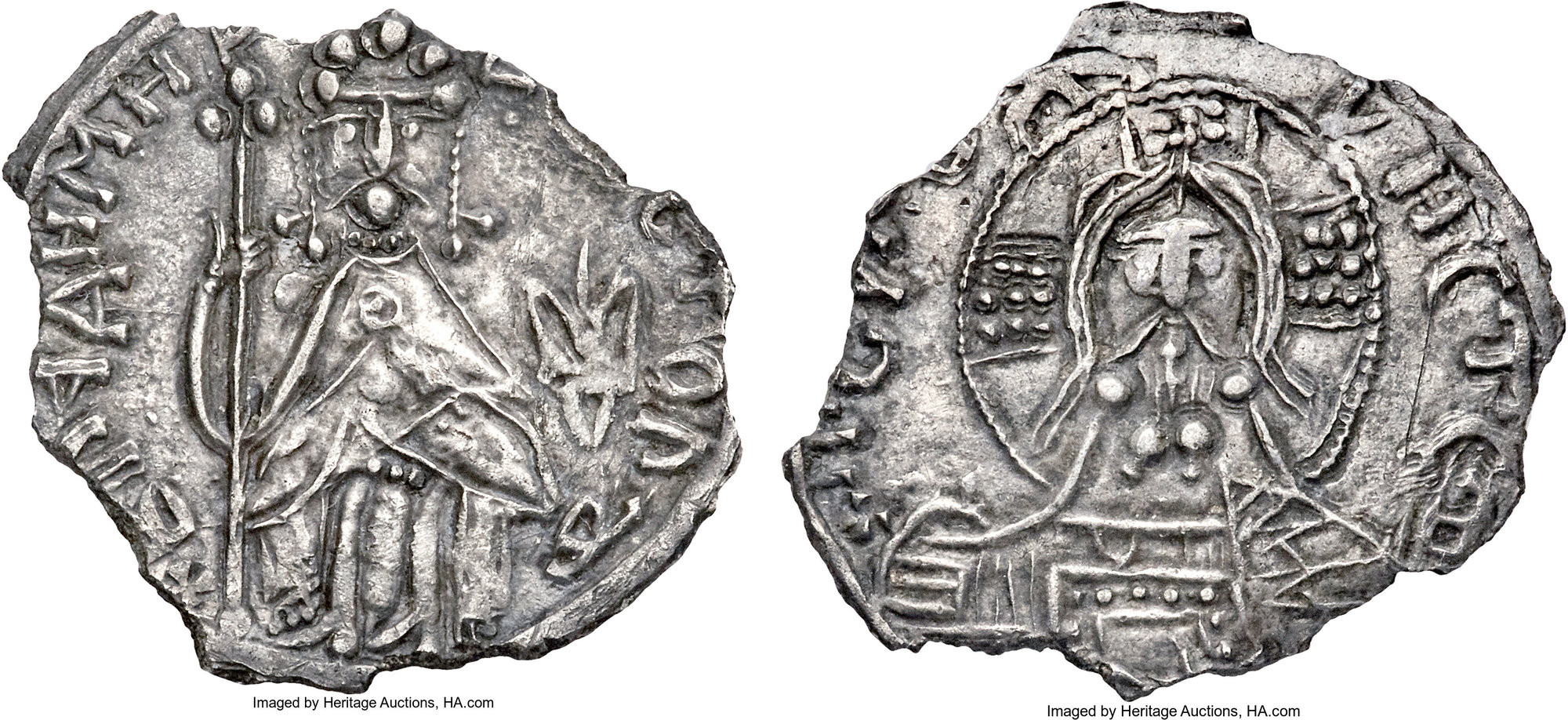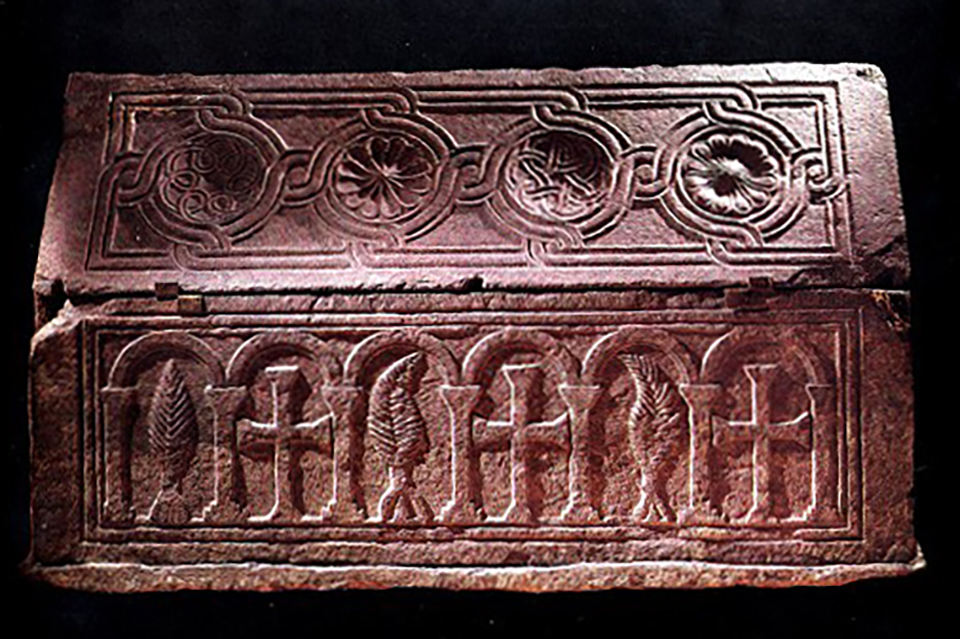Vladimir the Great is remembered as the founding father of the Kievan Rus’. Of Viking decent, he converted to Christianity in AD 987 and lost his barbarian aura in later chronicles
Now, I shall continue my criticism and condemnation of the wicked deeds of the King of the Russians, Vladimir. He obtained a wife named Helena [Anna] from the Greeks. She had formerly been betrothed to Otto the III, but was then denied to him, though fraud and cunning. At her instigation, Vladimir accepted the holy Christian faith, which, however, he did not adorn with righteous deeds. He was an unrestrained fornicator and cruelly assailed the feckless Greeks with acts of violence. He married one of his three sons to the daughter of Duke Boleslav, our persecutor… meanwhile, King Vladimir heard that his son had secretly turned against him at the urging of Duke Boleslav. He then seized not only his son and wife but also Reinbern [a cleric] as well, placing each of them in solitary confinement.
King Vladimir’s name is wrongly interpreted to mean “Power of Peace”. Indeed, what the impious hold among themselves or the occupants of this world possess is no true peace because it constantly changes. True peace is attained only by one who lays aside the soul’s every passion and seeks the Kingdom of Gods with the aid of patience which conquers every obstacle …
Subsequently, King Vladimir died in the fullness of his days and left his entire inheritance to his two sons. The third son remained in prison but later escaped and fled to his father-in-law, leaving his wife behind.
King Vladimir wore a cloth around his loins as an aphrodisiac, thereby increasing his innate tendency to sin. When Christi, the master of our salvation, ordered us to bind up our loins, overflowing with dangerous desires, it was greater continence that he demanded, not further provocation. Because the King heard from his preachers about the burning light, he tried to wash away the stain of his sins by constantly distributing alms….
Vladimir died when he was already weak with age and had held his kingdom for a long time. He was buried next to his wife in the great city of Kyiv, in the church of Christ’s martyr Pope Clemens. Their sarcophagi are displayed openly in the middle of the church. The King’s power was divided among his sons…
From: Thietmar of Merseburg: Chronicle, Vol VII, 72-74. Quoted from: Ottonian Germany. The Chronicon of Thietmar of Merseburg. Trsl. and ed. by David A. Warner. Manchester University Press 2001, pp. 358-59.
Vladimir was one of three sons of the Norman-Rus King of Kyivan Rus’, Svyatoslav. His grandfather was Oleg, son of Igor, son of Rørik, founder of the early Russian dynasty, the Ruriks or Rurikovichi.
Svyatoslav was the first of the rulers of Novgorod and Kyiv to acquire a “Slavic” name. While his name may be “translated” back to “Scandinavian (Sveineld), the same cannot be said for Vladimir, which is a distinctly Slavic name (perhaps derived from Slavic владь vladĭ “to rule” and *mēri “great”). In his youth, Vladimir was sent to govern Novgorod under the tutelage of his mother’s brother, Dobrynia. Unfortunately, his father died while sojourning there, and Vladimir’s brothers forced him to flee to Scandinavia. There, he succeeded in harnessing the help of an uncle. With an army of Varangian soldiers, he returned to Kyivan Rus’ and succeeded in besting his remaining brother, Yaropolk. By AD 980, he was in complete control of a single vast state reaching from the Black Sea to the Gulf of Finland, the Kyivan Rus’. King Vladimir also fortified his borders against the Bulgarian and eastern Nomads, thus consolidating his huge realm.
At the same time, Vladimir began to mint coins, with about 340 silver coins and 11 gold coins on record. The inscriptions on the gold coins read: “Vladimir on throne”, or “Vladimir and gold”. Likely, these coins were used as tokens or gifts of friendship. A significant stylistic element on these coins was the falcon (trident), which is usually depicted flying to the right of Vladimir. This falcon or trident has been suggested to be a distinctive stylistic element of Viking iconography. Today, the Falconis the national symbol of Ukraine.
Conversion to Christianity

As part of Vladimir’s endeavours to consolidate his “empire”, he converted to Christianity in AD 987. Until then, Vladimir had vigorously worked to uphold his father’s pagan institutions. However, at the end of the 80s, the Byzantine Emperor was troubled by insurrections and wars and needed to recruit mercenaries to his army. Vladimir granted his help on the condition that he might lay his hands on the ultimate status symbol, a true princess porphyrogenite.
Although formerly bethrothed to the Holy Roman Emperor Otto III, the the Emperor’s, Basil II (976–1025), sister was soon promised to Vladimir. Apart from the army of Varangian mercenaries, the price to pay was Vladimir’s conversion to Christianity. Finally, in 987, Vladimir was baptized with his retinue and “people”. The new Christian worship was based on the Byzantine rites and liturgies and in the Old Slavonic language. Through this manoeuvre, the new church was kept somewhat apart from German interference and any influence of the German church and bishops. Hence, the decidedly derogatory writings of Thietmar of Merseburg, quoted above.
One of the first churches built in Kyiv after the conversion was the Desiatynna, the church of tithes in Kyiv. Designed by Byzantine architects and dedicated about AD 996, it was the first pantheon of the rulers of Kyiv. Later, it was superseeded as the pantheon of the Rurik dynasty by St. Sophia (also built during the reign of Vladimir). Destroyed during the Mongol invasion, the Desiatynn now lies as a ruin at the centre of Kyiv.
Vladimir’s memory was kept alive by innumerable folk ballads and legends. In a recent article Christian Raffensperger has argued that what we believe to “know” about Vladimir is perhaps more a reflection of the cultural schemata of the Norse Scaldic poems, which flourished in the 10th century.
In later years, Putin has rebuilt the myth about about Vladimir claiming him as the founding father of Greater Russia consisting of Russia Proper, Ukraine, and Belarussia.
What did Vladimir look like?
To get a feeling for his persona, we might begin with the delightful description, which Leo the Deacon left us of his father. According to Leo:
“Svyathoslav arrived sailing along the river in a Scythian light boat, grasping an oar and rowing with his companions as if he were one of them. His appearance was as follows: he was of moderate height, neither taller than average nor particularly short; his eyebrows were thick; he had grey eyes and a snub nose; his beard was cleanly shaven, but he let the hair grow abundantly on his upper lip where it was bushy and long; and he shaved his head completely, except for the lock of a hair that hung down on one side, as a mark of the nobility of his ancestry; he was solid in the neck, broad in the chest and very well articulated in the rest of his body; he had a rather angry and savage appearance; on one ear was fastened a gold earring, adorned with two pearls and a red gemstone between them; his clothing was white, no different from that of his companions except in cleanliness (chapter IX:11)
From: The History of Leo the Deacon. Byzantine Military Expansion in the Tenth century.
Introduction, translation and annotations by Alice-Mary Talbot and Denis F. Sullivan.
Dumbarton Oaks Studies XLI. Washington 2005

Alas, we do not have a detailed description of Vladimir’s appearance. However, we possess some coins, which, together with the portrait quoted above by the German chronicler, Thietmar of Merseburg, provide a few fascinating details.
According to Thietmar, he wore a loincloth and not – we may presume – a long robe such as was the standard and prudent wear of royals and clerics at the turn of the 10th century. Indeed, on some of Vladimir’s coins, the King does look as if he is wearing a kilt. At least, he is portrayed showing legs wearing boots with high heels. The design of these coins differs significantly from the golden imperial coins often claimed to have acted as models. By contrast, the coins of Basil II show his portrait cut off at midriff and enface. To sum it up, the design of Basil’s and Vlaldimir’s coins do not look alike. We may presume the coins minted by Vladimir had a distinctive new look created under his auspices. It is generally believed that the minting began after Vladimir’s capture of the Byzantine mint city of Korsun around 990. Later, the city was returned to the Emperor, but he may have kept on some of the craftsmen as his retainers.
On one of the best examples preserved, Vladimir is seated on the throne, wearing an imperial crown, a short-robed dress, covered with a mantel and holding a shield in one hand and a sceptre in another; to his right is the trident – or rather falcon – clearly shown. Both this coin and those minted by his imperial brother-in-law sport rulers with elaborate moustaches.
FEATURED PHOTO:
One of the royal tombs presently exhibited at the Museum of St. Sophia. Source: Wikipedia
SOURCES:
Shared (Hi)Stories: Vladimir of Rus’ and Harald Fairhair of Norway
By Christian Raffensperger
In: The Russian Review (2009) Vol 68,pp. 569-82
Christian Russia in the Making
By Andrzej Poppe
Routledge 2007
READ ALSO:
